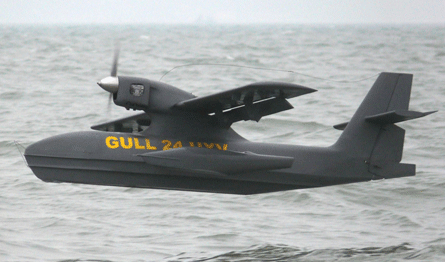Warrior (Aero-Marine) says it is negotiating a purchase order from the UK Autonomous Systems Technology Related Airborne Evaluation & Assessment (ASTRAEA) consortium for a Gull 36 amphibian unmanned air vehicle.
The aircraft will be used to support demonstrations of formation UAV operations under a project led by consortium member Flight Refuelling.
 |
|---|
Warrior managing director James Labouchere says that two Gull 36s are in manufacture, with the type to make its debut flight before the end of the year.
The second aircraft will be retained by Warrior to support ongoing development of the Gull series.
Sue Wolfe, aerospace strategy and innovation manager with the Welsh assembly and ASTRAEA's co-ordinator of UK government participation, says the planned formation flight demonstration will be conducted in west Wales.
"We are working with Flight Refuelling as part of ASTRAEA to look to an actual demonstration of unmanned air system formation flying. That is a part of the big picture of ASTRAEA, and Flight Refuelling is working with Warrior. The intention is that they will be flying in Wales to demonstrate that next year."
Warrior's existing Gull 24 demonstrator had achieved 40 flights by mid-July after making its debut sortie in September 2005. That type is fitted with a Blue Bear Systems Research autopilot, unlike the earlier Centaur UAV demonstrator, which was remotely controlled. The Gull 24 also introduced outrigger floats on the hull rather than wingtip-mounted floats, and a folding wing.
The Gull 36 will have a span of 4m (13ft) and a maximum take-off weight of 70kg (155lb). It will be powered by a 3W 160cc horizontally-opposed two-cylinder engine. It will also again feature Blue Bear guidance and control systems.
Labouchere says Gull 36 is expected to be able to take off and land in conditions of up to sea state 5. The new type is also expected to be the first amphibious UAV to be deployed and retrieved aboard a moving warship through the use of a tow sled launch and recovery system (LARS), designated "Warrior Fisher".
That system would see the Gull 36 mated with the Warrior Fisher body and lowered into the water from the warship stern, with the aircraft then separating and taking off while the sled is reeled back aboard.
At the completion of a mission the UAV would land ahead of the ship. It would then autonomously taxi on the surface to rendezvous with the moving Warrior Fisher body and mate with it for recovery. The Siemens-owned Roke Manor Research is helping develop sensors to aid the UAV during the surface navigation phases of the process.
Labouchere says the LARS will allow the UAV to be deployed and launched regardless of the angle of the wind relative to the ship's course. It would also reduce interference with existing operational procedures aboard as the UAV is effectively shifted out of the envelope of ship's sensors and weapon systems.
A prototype LARS is being developed with funding support from the UK Defence Technology Council and has undergone tow testing.
Warrior has undertaken design work on a larger UAV configuration, designated the Gull 68, says Labouchere. This is to have a 7.6m span. Initial activity on a fourth version, Gull 90, is also under way.
Source: Flight International























